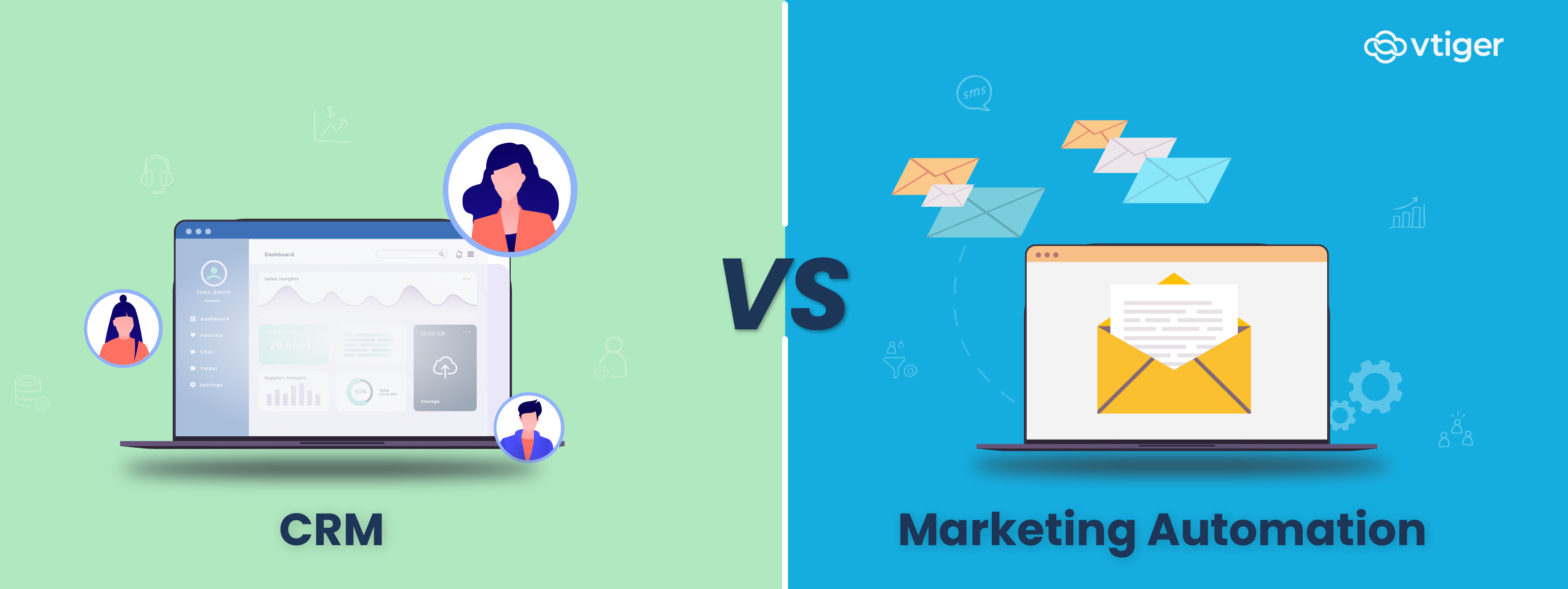Growth today is shaped as much by how a business remembers its customers. CRM is the organised memory, capturing interactions and guiding teams to build trust over time. Marketing Automation is an amplifying segment that sends the right message to the right audience without losing speed. The real question is not which tool is better, but which one fits the stage your business is in. This guide explores those differences and shows how the two can create impact together when used with purpose.
What is a CRM? A Simple Breakdown for Businesses
A CRM system is a software solution that helps businesses manage and analyze their interactions with current and potential customers. Its main function is to organize and centralize all customer-related data. It is a single, shared record of every customer, accessible to your entire team.
Key functions of a CRM like Vtiger include:
- Customer Data Management: It stores all customer information in one place, from contact details to their purchase history and past conversations.
- Sales Process Tracking: It allows your sales team to follow the progress of a potential customer through the sales pipeline, from initial contact to a closed deal. This helps ensure no opportunity is missed.
- Service and Support Management: It enables customer support teams to handle and resolve service requests efficiently by providing a complete view of the customer’s history.
What is Marketing Automation? A Simple Breakdown for Businesses
Marketing automation is a software solution that automates repetitive marketing tasks. Its main goal is to attract new leads and guide them through a journey until they are ready to talk to a salesperson. This allows your team to focus on big-picture strategies. Key features include:
Automated Campaigns: You can design email or SMS campaigns that run independently. For instance, when someone subscribes to a newsletter, the system can immediately send a welcome message followed by scheduled updates, eliminating the need for manual follow-ups.
Lead Nurturing: The platform monitors how prospects interact with your content. Did they open an email, click a link, or visit your website? Based on this behaviour, it assigns scores that help the sales team identify the most engaged leads.
Audience Segmentation: Instead of sending the same message to everyone, the system allows you to group people into targeted lists. You might create one list for a specific location and another for users interested in a certain product, ensuring communication is tailored and relevant.
Analytics: Every campaign produces insights. Reports show which messages attract the most attention, which links generate clicks, and which content sparks genuine interest. This information helps refine future campaigns and improve overall results.
CRM vs Marketing Automation – Key Differences Explained
While they are often used together, CRM applications and marketing automation tools have distinct functions. Here’s a clear breakdown of their differences:
| Parameter | CRM (Customer Relationship Management) | Marketing Automation |
| Main Objective | Manages and strengthens relationships with existing customers and qualified leads. | Attracts, captures, and nurtures new leads from a broad audience. |
| Primary Users | Sales and customer service teams. | Marketing teams. |
| Customer Journey Stage | Handles the post-lead phase: sales, service, and retention. | Focuses on the pre-sale phase: awareness and lead generation. |
| Data Type | Stores customer data, including contact information, purchase history, and service interactions. | Collects prospect data, such as website visits, email engagement, and form submissions. |
| Key Activities | Manages one-on-one interactions like sales calls, deal negotiations, and support tickets. | Automates large-scale, one-to-many communications like email sequences and social media posts. |
| Core Metrics | Sales conversion rates, customer retention, sales cycle length, and customer lifetime value. | Lead generation rate, email open/click rates, lead-to-MQL (Marketing Qualified Lead) conversion, and campaign ROI. |
In simple terms, CRM applications help you manage the customers you already have, while marketing automation helps you find and prepare the customers you want to acquire. The meaning of CRM revolves around the human interaction and relationship-building aspects of the business, while marketing automation is about using technology to efficiently reach a wide audience.
How CRM and Marketing Automation Work Together
The greatest benefit comes from integrating these two systems. When connected, they create a seamless, continuous workflow that guides a customer from initial contact to post-sale activities.
A platform like Vtiger, which offers both capabilities, makes this integration seamless.
Here is a practical example of how they work together:
- Lead Capture: A person finds your blog and signs up for a newsletter. This information is automatically captured by your marketing automation tool.
- Lead Nurturing: The system enrolls them in a series of automated emails designed to provide valuable information. Based on their engagement (e.g., they click a link to your pricing page), the system increases their lead score.
- Sales Handoff: Once the lead’s score reaches a predefined level, indicating they are highly interested, the marketing automation tool automatically creates a new contact and a deal in the CRM for the sales team. The sales rep receives a notification with a complete history of the lead’s online activity.
- Sales Engagement: The sales team can then reach out with a personalized message, already knowing what the prospect is interested in.
- Post-Sale Follow-up: After the deal is closed, the CRM can trigger an automated marketing campaign to onboard the new customer. This could include a series of emails with product tutorials or a survey to ask for feedback after a few weeks.
This unified approach ensures that no lead is lost and every interaction is recorded, giving all teams a holistic customer view.
Benefits of Using CRM Applications
A Customer Relationship Management system functions as a structured framework for understanding and engaging with clients. In addition to storing information, it provides a certain level of clarity that enables businesses of any scale to strengthen loyalty, improve communication, and make decisions guided by evidence rather than assumptions.
- Organized Customer Data: With a CRM, all customer information is in one place. For a small B2B firm, this means every team member knows a client’s history, who they’ve talked to, and what their needs are. No more lost notes or missed opportunities.
- Better Communication: A CRM lets sales, support, and marketing teams see what the others are doing. If a customer calls with an issue, the support agent can see they’ve just signed a new deal and handle the situation with more care. This unified view builds trust and keeps customers happy.
- Stronger Relationships: A CRM helps you go beyond just a sale. By tracking customer preferences and past interactions, you can send personalized messages and offers. For instance, a financial advisor can send a birthday wish to a client, or an education consultant can send a timely reminder about an application deadline.
- Accurate Sales Forecasts: By tracking every deal in the pipeline, a CRM provides clear data on sales performance. This helps business owners make more informed decisions about hiring, budgeting and future strategy. It helps them see what’s working and where they need to improve.
Benefits of Using Marketing Automation
For companies competing in diverse and fast-moving markets, marketing automation offers more than convenience. By combining data with timing, it turns everyday marketing into a structured driver of growth. The following benefits bring a direct impact on any business’s revenue:
- Targeted Campaigns: In countries with a diverse culture, one-size-fits-all marketing just doesn’t work. Automation lets you segment your audience by location, language, or interest. This means you can send a campaign for an upcoming festival to customers in a specific region or a product launch to a group of interested prospects.
- Saves Time and Effort: Repetitive tasks like sending follow-up emails, posting on social media, or tracking leads manually are time-consuming. Automation handles these tasks for you, freeing up your team to focus on creative and strategic work.
- Smarter Lead Management: Not every lead is ready to buy. Automation tools can automatically score leads based on their behavior. This means your sales team spends their time talking to genuinely interested people, instead of chasing cold leads.
- Better Conversion Tracking: You can see which of your marketing efforts are actually working. Did a specific ad campaign bring in high-quality leads? Did a new blog post get people to sign up for your newsletter? Automation gives you the data to prove what’s working and make smarter decisions with your marketing spend.
Common Challenges When Implementing CRM and Marketing Automation
CRM and Marketing Automation offer significant advantages, but adopting them is rarely smooth sailing. Businesses often encounter obstacles such as integration difficulties, limited user adoption, or unclear strategy, which can reduce the overall impact. Recognising these challenges early helps organisations prepare better and gain the full value of these systems.
- Resistance to Change: Employees might be used to their old way of working with spreadsheets and manual lists. Getting them to adopt a new system can be a challenge, and without proper training, the tool won’t be used effectively.
- Budget Concerns: For a small business, the cost of a new system can seem overwhelming. It’s essential to view it as an investment that will yield long-term benefits, including increased efficiency and sales, rather than just as a cost.
- Data Quality: If the data you put into the system is bad, the results will be bad. Inaccurate or incomplete data can lead to poor decision-making and frustrating experiences for your customers.
- Integration Issues: Many businesses use multiple tools. Connecting a new CRM or marketing automation platform with existing software can be complex and sometimes lead to data syncing problems.
How to Choose Between CRM and Marketing Automation for Your Business
Selecting the right system begins with understanding what your business needs the most. This section provides a clear framework to help you evaluate both options and make an informed decision.
Start with a CRM if:
- Your primary goal is to enhance customer service and strengthen relationships with your existing clients.
- You have a small but growing sales team that needs to organize its sales process.
- Your business relies on personal, one-on-one interactions to make sales.
Start with Marketing Automation if:
- Your primary goal is to generate a large number of new leads and scale your marketing efforts.
- You have a lot of website traffic or social media followers and need an efficient way to manage them.
- Your business uses content, email, and social media to reach a wide audience.
For a new startup, CRM software is often the best first step. It helps you manage and track your early customer relationships, which are the most important. As you grow and need to reach more people, you can then add marketing automation to your toolkit.
Best Practices for Integrating CRM and Marketing Automation
Maximising the impact of both systems requires careful alignment. Combining CRM applications and marketing automation effectively allows teams to synchronise operations, boost productivity, and create a unified approach between marketing and sales.
- Sync Your Data: Ensure that information flows freely between your tools. When a new lead is created in your marketing automation system, it should automatically appear in your CRM. This eliminates manual data entry and keeps everything up-to-date.
- Align Your Teams: Get your marketing and sales teams on the same page. Define what a “qualified lead” means so marketing knows when to hand off a prospect and sales knows what to expect.
- Map the Customer Journey: Identify each stage a prospect goes through, from first awareness to becoming a customer. Set up workflows in your tools that support every step, guiding prospects smoothly along the path. Many businesses use open source CRM to navigate this visibility through multiple facets of customer journeys.
- Analyze and Adjust: Regularly check your performance metrics. Are the leads you’re passing to sales converting? Are your automated campaigns getting good engagement? Use this data to fine-tune your strategy.
Future Trends – CRM and Marketing Automation
Personalisation and seamless communication are becoming the norm. Emerging trends in CRM applications and marketing automation aim to deliver timely, relevant experiences that anticipate customer needs and strengthen loyalty.
- AI-Powered Personalization: Tools will use AI to predict what a customer wants next, allowing you to offer them the right product at the right time. They’ll also use AI to create more personalized messages and content automatically.
- Conversational Interfaces: Expect more businesses to use chatbots and voice assistants. CRMs and marketing automation will be integrated with these tools to provide instant, helpful responses and guide people through the sales process.
- Vernacular Content: As more users come online, there will be a bigger need for tools that support local languages. Future solutions will make it easy to create and automate campaigns in Hindi, Tamil, Bengali, and other regional languages.
Conclusion – Finding the Right Balance for Your Business
CRM and marketing automation are not competing tools. They are two sides of the same coin, each essential for modern business growth. CRM applications serve as the foundation for building and maintaining strong relationships, while marketing automation is the your engine for generating new business at scale.
For businesses, the key is to understand your specific needs. Start with the tool that solves your most immediate challenge. Whether it’s organizing your customer data with a CRM or generating more leads with marketing automation, the most important step is to begin. By using these technologies, you can build a more efficient, customer-focused business that is ready for the future.
FAQs – Everything You Need to Know
Q1. Can I use CRM and marketing automation together?
Yes, and you should! They work best when integrated. Marketing automation attracts and nurtures new leads, then passes the top-scoring ones to the CRM, where your sales team can turn them into customers and manage the ongoing relationship.
Q2. Which is more important for a small business?
For most small businesses, a CRM is the first and most crucial step. It helps you organize your customer data and build solid relationships, which is key to early growth. Marketing automation can be added later as you need to scale your lead generation efforts.
Q3. How do these tools improve customer satisfaction?
They help you be more responsive and personal. A CRM provides your team with a comprehensive history of a customer’s interactions, enabling them to offer more personalized and effective service. Automation sends timely, relevant messages that make customers feel valued and understood.
Q4. Is training necessary?
Yes, proper training is essential for your team to use the tools effectively. A good provider will offer easy-to-use platforms and training resources to ensure a smooth transition.
Q5. Can marketing automation work in regional languages?
Many modern platforms are built to handle multiple languages. This allows you to create campaigns in regional languages, which can help you connect with a wider audience and get better results.
Q6. How secure is my data?
Reputable providers take data security seriously. They use encryption, secure servers, and strict privacy policies to protect your information. Always choose a trusted brand that follows global security standards.
Q7. Do I need both tools to scale my business?
To scale effectively, you will likely need both. A CRM helps you manage your growing customer base, while marketing automation helps you fill your sales pipeline with a constant flow of new leads.
Q8. What industries benefit the most?
Any industry with a sales process and customers can benefit. They are especially useful for e-commerce, real estate, education, healthcare, and software companies.
Q9. How much does it cost?
The cost varies, but many cloud-based solutions offer affordable plans based on the number of users or contacts you manage. This makes them accessible for businesses of all sizes.



